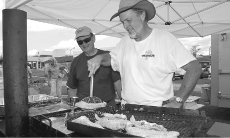Helping Others
The compassion and generosity of the American people is never more evident than after a disaster. People want to help. Here are some general guidelines on helping others after a disaster:
Volunteer! Check with local organizations or listen to local news reports for information about where volunteers are needed. Note: Until volunteers are specifi cally requested, stay away from disaster areas.
Bring your own food, water, and emergency supplies to a disaster area if you are needed there. This is especially important in cases where a large area has been affected and emergency items are in short supply.
Give a check or money order to a recognized disaster relief organization. These groups are organized to process checks, purchase what is needed, and get it to the people who need it most.
Do not drop off food, clothing, or any other item to a government agency or disaster relief organization unless a particular item has been requested. Normally, these organizations do not have the resources to sort through the donated items.
Donate a quantity of a given item or class of items (such as nonperishable food) rather than a mix of different items. Determine where your donation is going, how it’s going to get there, who is going to unload it, and how it is going to be distributed. Without suffi cient planning, much needed supplies will be left unused.
 |
|
For More Information
If you require more information about any of these topics, the following are resources that may be helpful.
FEMA Publications
Helping Children Cope with Disasters. L-196. Provides information about how to prepare children for disaster and how to lessen the emotional effects of disaster.
When Disaster Strikes. L-217. Provides information about donations and volunteer organizations.
Repairing Your Flooded Home. FEMA 234. This 362-page publication provides a stepby- step guide to repairing your home and how to get help after a fl ood disaster. Available online at www.fema.gov/hazards/fl oods/lib234.shtm
After a Flood: The First Steps. L 198. Tips for staying healthy, cleaning up and repairing, and getting help after a fl ood. Available online at www.fema.gov/hazards/fl oods/ aftrfl d.shtm